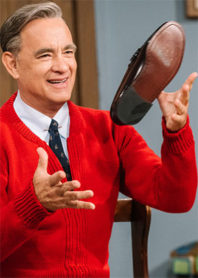
I didn’t know a lot about Fred Rogers. His death in 2003 was an event so important that my high school put it on that year’s yearbook. Then I put my yearbook down and watched my equivalent of Mister Rogers’ Neighborhood, which was Much on Demand. He returned to the social consciousness and thus, my consciousness, last year with Morgan Neville’s documentary about him. And he’s staying within that consciousness with Marielle Heller’s A Beautiful Day in the Neighborhood, a film ten years in the making that is only tangentially about him. When he was alive, he and the show were the exact opposite of the loud sketch shows dominating late 1960s television.
Rogers functions similarly today, or at least that’s what audiences want him to be. Most of our movies, with or without superheroes, tend to diagnose and fight our social ills. We go to him, on the other hand, with the idea that he’s human eye bleach, the nicest person in the world helping us forget how mean the real world is. But Heller knows it’s not that easy. She opens her film with a fictional Rogers (Tom Hanks) showing us a picture of one of his new friends, Lloyd Vogel (Matthew Rhys, his character a fictional stand-in for Tom Junod), with cuts and blood all over his face. What kind of movie is this?
There are two reasons why this puzzling reaction came from me. The first is that I need to stop taking films at face value and see how they stray from conventions. The second is because maybe this is unconventional and doesn’t just use Lloyd’s face for shock value. I imagined a different film when the trades announced a Fred Rogers biopic. I thought I would get John Mulaney as Rogers, fighting to keep public access shows like his on the air. But instead, this film is about Lloyd, a man, when he doesn’t get his face bloody, is a successful magazine writer. This would align with Heller’s interests, since she previously directed Can You Ever Forgive Me, another movie about a cynical New York writer.
Lloyd is the unlikely candidate to write a puff piece on Rogers. Lloyd’s editor Ellen (Christine Lahti) tells him that Rogers was the only person willing to talk to despite eviscerating his previous subjects. His wife Andrea (Susan Kelechi Watson) gives him a similar warning not to ruin his childhood. His first phone interview with Rogers wasn’t productive, the latter only giving him stock answers. Personal interviews were worse, since Rogers seemed like the nicest guy ever. To him, this was an act and he was going to find and interview his way into Rogers’ darker side.
Both Lloyd and Rogers shuttle themselves from New York to the latter’s studio in Pittsburgh. And these Pittsburgh scenes produces the film’s best images. Heller had her DP Jody Lee Lipes composed some of these studio shots. And those shots obscure faces in real life and reveal them either on television screens or in corners. Sure, this way of filtering emotion seems like a trope in films about the arts, but it’s still effective under the hands of these filmmakers capturing Hanks’ most layered performance in years.
These interviews between Lloyd and Rogers also reflect the film’s visual misdirection. Rogers has a habit of indirectly answering Lloyd, which only frustrates the latter because he thinks the former is being evasive. I’m not the one to judge on other people’s levels of maturity. However, Lloyd is basically 85% of the characters in this film who decide to stick with their own emotions so much so that they initially lack empathy. And of course the point is for these characters to gain that empathy. Which is predictable enough of a trajectory. But does it work? Absolutely, and we have everyone involved to thank for that.
- Release Date: 11/22/2019


